Dog Behavior Problems and TrainingDog Barking Problems Part 1 |
|
|
What does it mean when a dog barks? The bark is the dog's word, and it can mean many things. Your dog barks when he is alerting you to an intruder, when he is afraid, when he is playful, and when he is bored. Barking is caused by the presence of stimuli such as strange people, dogs, sights or sounds, the owner's absence, or as an attention seeking mechanism. The easiest way to control barking is to socialize your dog to make him comfortable around people, places and things and to instill in him a strong chew toy habit so that he is mentally and physically exercised and occupied. However, just as you would not attempt to completely silence a person, you should not try to completely stop your dog from barking. Your dog just needs to learn some basic bark control such as when to bark and for how long. Regardless of the reason for your dog barking, your goal is to properly socialize him, to teach him to focus on something other than barking, and to teach him to speak and be quiet on command so you can control when and for how long he barks. Alarm Barker: Dogs who bark at the presence of intruders can be a valuable asset. It is very ironic that barking dogs are now such a problem in our society when it is also considered as an alarm. Actually, barking is believed to be one of the main reasons we domesticated dogs in the first place and one of the reasons we live with dogs today. Usually, it is not the barking that is a problem, just that the dog is a little too enthusiastic. Most people want their dogs to let them know when someone has stepped onto the property. Barking only becomes a problem if the dog does not settle afterwards. Teach your dog to bark and be quiet on cue; thereby having an on/off switch. To implement this training, invite three friends to come over for a speak-and-shush party, and within half an hour you will have a well- trained barker. Have your dog's treat on hand. Next, instruct your visitors to knock on the door and reward your dog by saying "thank you", followed by a treat when he barks. Your dog may look a bit shocked for a moment. After all, he is probably used to being yelled at when he barks. Then, to get him to be quiet, say "shush," and waggle a piece of treat in front of his nose. Once he sniffs the food, he will be quiet and so give him the treat as a reward. Repeat this many times, and your dog will become increasingly aware of how much fun it is to speak on request and how rewarding it is to shush on request. Go to Dog Barking Problems Part 2 Back to the Dog Behavior Problems and Training page
| |
|
Related News About Dogs ' ); // get rid of newsfeed display by carp CarpConf('poweredby',''); CarpCacheShow('http://dogguidance.com/dogblog/?feed=rss2'); ?>
|
|
|
|
|
|
Copyright © 2006-2007 dogguidance.com |


